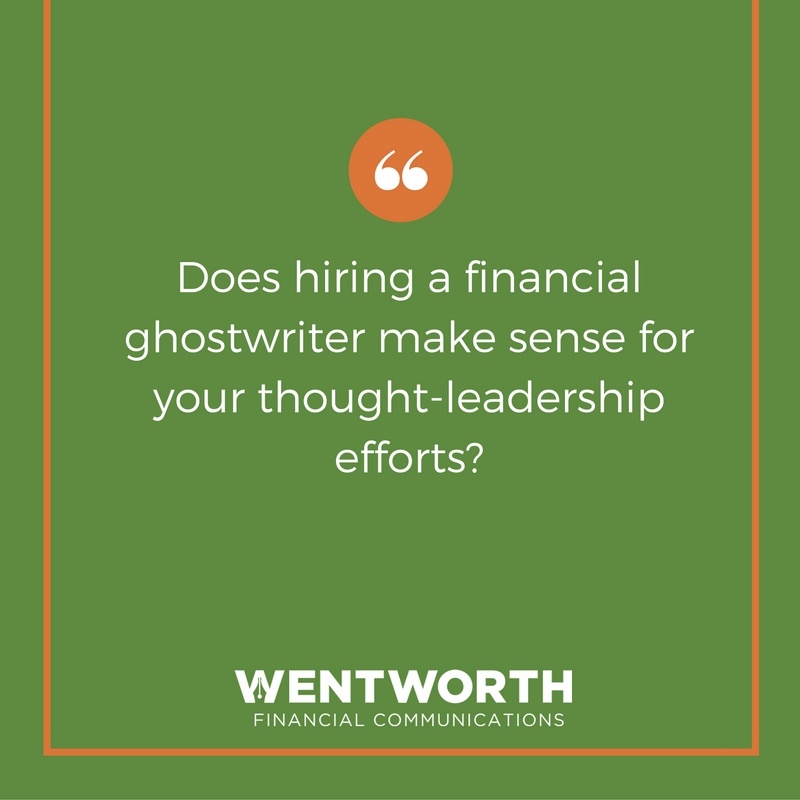White papers, e-books, blogs, and other forms of thought leadership have become valuable commodities in financial services marketing. In a recent post, we looked at some of the reasons why asset management, investment banking, private equity, and accounting firms hire ghostwriters (or freelance writers) to turn the firm’s expertise into thought-leadership pieces.
So what does working with a ghostwriter look like? How can an outsourced writer or freelance writer help? To answer these questions, let’s look at three scenarios that illustrate the ways that ghostwriters can work with you.
Starting With a Blank Slate
If you’re like a lot of portfolio managers, investment bankers, or other financial advisors, you have lots of topics or general ideas that could make for great white papers or blog posts. But you haven’t been able to get past that point. You don’t even know what the next step would be for turning that idea into a completed piece that you can send to your clients and prospects.
A ghostwriter can help you develop a theme for your white paper, e-book, or article, narrow the scope, and shape it in a way that will be compelling for your target audience. By working with you to develop an outline, the ghostwriter will create a structure for the piece. The ghostwriter will then interview your subject-matter experts and work with you to round up the necessary research to substantiate your ideas. A good financial ghostwriter can turn a 30- or 60-minute conversation with you into a first draft that is at least 90% of where the finished product needs to be. Then they will work with you to fine tune the ideas and finalize the piece.
Putting Meat on the Bones
Maybe you have more than an idea. Maybe you and your team have created an outline that lists the major points you’d like to make. Or maybe you have a slide deck you commonly use in client presentations that you’d like to turn into a polished piece of writing. You’ve already created the skeleton, but now you need someone to put meat on the bones.
This is another great place to bring in a ghostwriter. The outsourced writer will start by reviewing the outline to make sure that it tells the story in the most compelling way for your audience and to determine what stats, examples, or other proof points are needed to support your ideas. Then the ghostwriter will dig in and interview your subject-matter experts to add color commentary to the themes in your outline. Based on those interviews, the writer will turn the outline into a first draft and then work with your team to refine and perfect it.
If the ghostwriter did his or her job well, you will look at the draft and think, “That’s exactly what I wanted to say.”

Polishing the Rough Edges
Sometimes you already have a first draft of a piece. It may be a blog post that you think could be a great article for publication or a rough version of an article that could be refined and developed into an in-depth, researched white paper. This is another place to bring in a financial ghostwriter, who can edit your work and take it to the next level.
When most people hear the word “editing,” they think of correcting grammar errors, ensuring style consistency, or wordsmithing to correct any awkward phrasing. While this is certainly part of editing, a good ghostwriter will do much more than this. A ghostwriter won’t just look for ways to polish what you’ve already said; the writer will look for ways to make sure you are saying the right things.
One of the biggest benefits of working with a ghostwriter is that the ghostwriter brings an outside perspective in evaluating whether your piece hits the right notes. The ghostwriter will ask questions such as:
- Does the work focus on things that your audience cares about? Does it adequately explain why the audience should care?
- Are there unanswered questions or gaps in the logic?
- Would charts, sidebars, pullout quotes, or other visual elements help tell the story and drive home the important ideas?
Ghostwriters can help you even if you’re a good writer! A ghostwriter can take a small amount of your time and multiply it, taking care of background research and fact checking, filling in gaps, and rewriting sections to produce a high-quality finished product.
As a successful financial services professional, you’re already a thought leader to your existing clients. Whether you’re starting from a blank slate, an outline of your ideas, or a first draft, working with a ghostwriter can be the catalyst to turn your ideas into thought leadership for a much wider audience.
About the Author
 Scott Wentworth is the founder and head writer of Wentworth Financial Communications. He has served as a ghostwriter for portfolio managers, investment bankers, attorneys, and other thought leaders across the financial services industry. It took all the willpower he could muster to not include “Who You Gonna Call?” in the title of this blog post.
Scott Wentworth is the founder and head writer of Wentworth Financial Communications. He has served as a ghostwriter for portfolio managers, investment bankers, attorneys, and other thought leaders across the financial services industry. It took all the willpower he could muster to not include “Who You Gonna Call?” in the title of this blog post.
